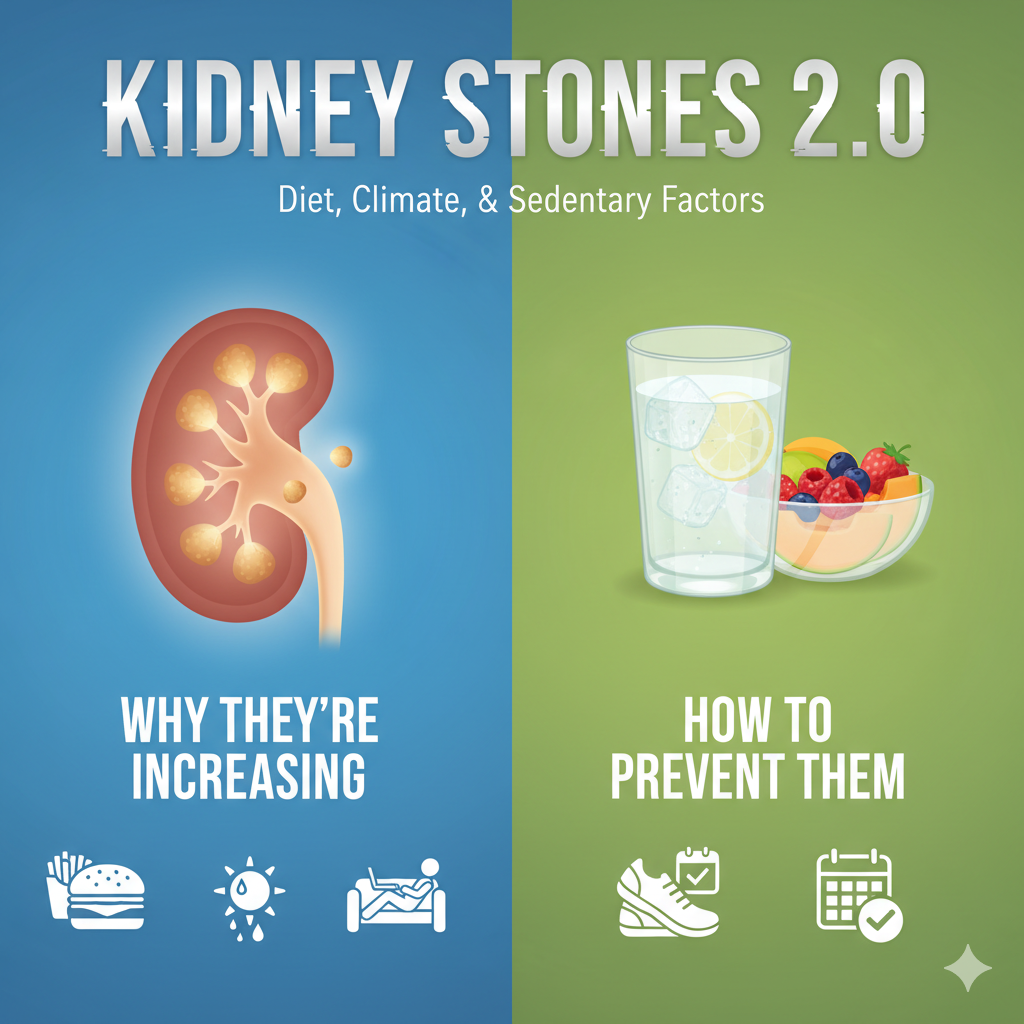The excruciating pain of a kidney stone is something no one wants to experience. Unfortunately, these unwelcome visitors are becoming increasingly common, earning them the moniker “Kidney Stones 2.0.” But why the surge, and what can we do to protect ourselves in our modern, fast-paced lives? Let’s dive into the evolving landscape of kidney stone formation and how to proactively prevent them.
The Rise of Kidney Stones 2.0: A Perfect Storm
The increase in kidney stone incidence isn’t random; it’s a convergence of factors deeply embedded in our contemporary lifestyle.
1. The Modern Diet: A Recipe for Stones?
Our plates have changed dramatically over the last few decades.
- High Sodium Intake: Processed foods, restaurant meals, and packaged snacks are often loaded with sodium. High sodium can increase calcium in your urine, a primary component of many kidney stones.
- Sugar Overload: Diets high in refined sugars and high-fructose corn syrup can alter urine composition, increasing the risk of stone formation.
- Insufficient Hydration (Often Hidden): While we might drink other beverages, many modern drinks (soda, sugary juices) don’t hydrate as effectively as water. Furthermore, busy schedules often mean we forget to drink enough plain water throughout the day.
- Animal Protein & Oxalate: While protein is essential, excessive intake of animal protein can lead to increased uric acid and calcium excretion, both risk factors. Additionally, some healthy foods high in oxalates (like spinach, almonds, and chocolate) can contribute, especially if not balanced with calcium.
2. Climate Change and Dehydration:
It might sound surprising, but rising global temperatures play a role.
- Increased Sweating: Hotter climates and more frequent heatwaves mean we sweat more. If fluid intake doesn’t increase proportionally, this leads to chronic dehydration, concentrating urine and making it easier for stone-forming minerals to crystallize.
- “Stone Belt” Expansion: Regions historically known for higher kidney stone rates (often hotter climates) are expanding as temperatures rise globally.
3. The Sedentary Trap:
Our increasingly desk-bound lives also contribute to the problem.
- Reduced Bone Density & Calcium Release: Lack of physical activity can lead to bone demineralization, releasing calcium into the bloodstream and subsequently into the urine.
- Slower Urinary Flow: Being sedentary can lead to less frequent urination and a slower flow, giving minerals more time to settle and form crystals in the kidneys.
- Obesity Link: Sedentary lifestyles often go hand-in-hand with weight gain. Obesity is an independent risk factor for kidney stones, influencing metabolic pathways that promote stone formation.
Preventing Kidney Stones in a Modern World: Your Action Plan
The good news is that many of these risk factors are within our control. By making conscious choices, you can significantly reduce your chances of experiencing Kidney Stones 2.0.
1. Hydration is King (and Queen!):
- Water, Water, Everywhere: Make plain water your primary beverage. Aim for 8-10 glasses a day, more if you’re active or in a hot climate. Keep a water bottle handy.
- Lemon Power: Adding lemon to your water provides citrate, which can help prevent calcium stones from forming.
- Monitor Urine Color: Your urine should be pale yellow. Darker urine is a sign of dehydration.
2. Rethink Your Plate:
- Cut Down on Sodium: Read labels, limit processed foods, and cook more at home to control salt intake.
- Moderate Animal Protein: Enjoy protein, but aim for balanced meals. Consider incorporating more plant-based proteins.
- Balance Oxalate-Rich Foods: If you’re prone to calcium oxalate stones and enjoy foods like spinach, nuts, or chocolate, pair them with calcium-rich foods (like dairy or fortified alternatives) at the same meal. Calcium binds with oxalate in the gut, preventing its absorption.
- Limit Added Sugars: Reduce sugary drinks and foods high in refined sugars.
3. Get Moving:
- Break the Sedentary Cycle: Incorporate regular physical activity into your routine. Even short walks throughout the day can make a difference.
- Stand Up Often: If you have a desk job, stand up, stretch, and walk around every 30-60 minutes.
- Aim for 150 Minutes: Strive for at least 150 minutes of moderate-intensity exercise per week, as recommended by health guidelines.
4. Be Mindful of the Heat:
- Stay Cool: Seek shade, use air conditioning, and avoid strenuous activity during the hottest parts of the day in summer.
- Increase Fluid Intake: Always carry water with you, especially when exposed to heat or engaging in physical activity.
Kidney stones are certainly on the rise, but they don’t have to be your destiny. By understanding the modern factors contributing to their increase and proactively adjusting your diet, hydration habits, and activity levels, you can effectively prevent Kidney Stones 2.0 and keep your kidneys happy and healthy. If you have a history of kidney stones or concerns, always consult with a healthcare professional for personalized advice.

